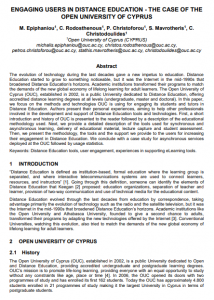ORCID | DBLP | Scopus | Google Scholar | ResearchGate | Web Of Science | Semantic Scholar | MathSciNet
2015 |
|
 | Epiphaniou, Michalis; Rodosthenous, Christos; Christoforou, Petros; Mavrotheris, Stathis; Christodoulides, Christopher Engaging users in distance education – The case of the Open University of Cyprus Proceedings Article In: Proceedings of the 9th International Technology, Education and Development Conference (INTED2015), pp. 6092–6101, IATED, 2015, ISSN: 2340-1079. Abstract | BibTeX | Tags: distance education tools, experiences in supporting elearning tool, user engagement | Links: @inproceedings{EPIPHANIOU2015ENG,The evolution of technology during the last decades gave a new impetus to education. Distance Education started to grow to something noticeable, but it was the Internet in the mid-1990s that broadened Distance Education’s horizons. Academic institutions transformed their programs to match the demands of the new global economy of lifelong learning for adult learners. The Open University of Cyprus (OUC), established in 2002, is a public University dedicated to Distance Education, offering accredited distance learning degrees at all levels (undergraduate, master and doctoral). In this paper, we focus on the methods and technologies OUC is using for engaging its students and tutors in Distance Education. Authors present their personal experiences, aiming to help other professionals involved in the development and support of Distance Education tools and technologies. First, a short introduction and history of OUC is presented to the reader followed by a description of the educational methodology used. Next, we provide a detailed description of the tools used for synchronous and asynchronous learning, delivery of educational material, lecture capture and student assessment. Then, we present the methodology, the tools and the support we provide to the users for increasing their engagement in Distance Education. We conclude with a case study for asynchronous services deployed at the OUC followed by usage statistics. |
